Home > Directory of Drawing Lesson > Drawing People > Drawing Feet & Legs > Drawing Children's Thighs, Legs, and the Foot
How to Draw Kid's Thighs, Legs and Feet with Following Drawing Lesson on Drawing Children's Feet & Legs
|
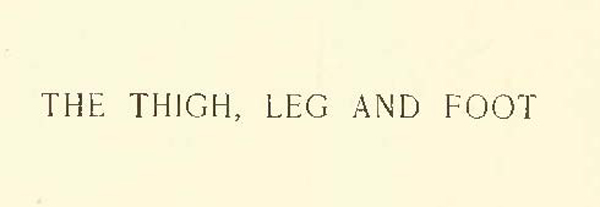
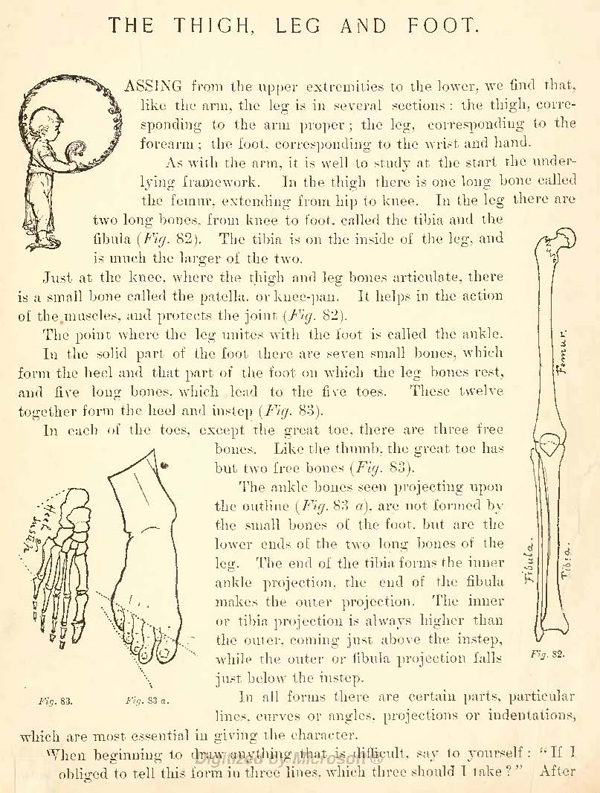
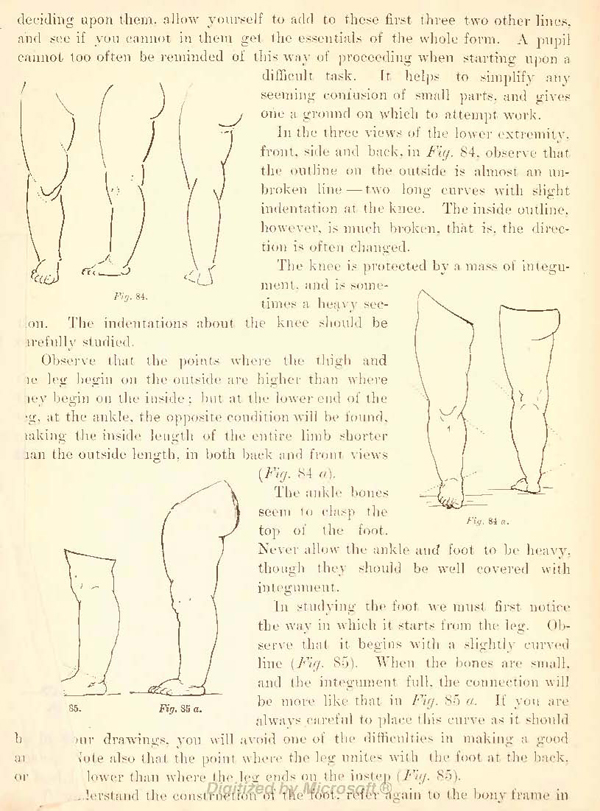
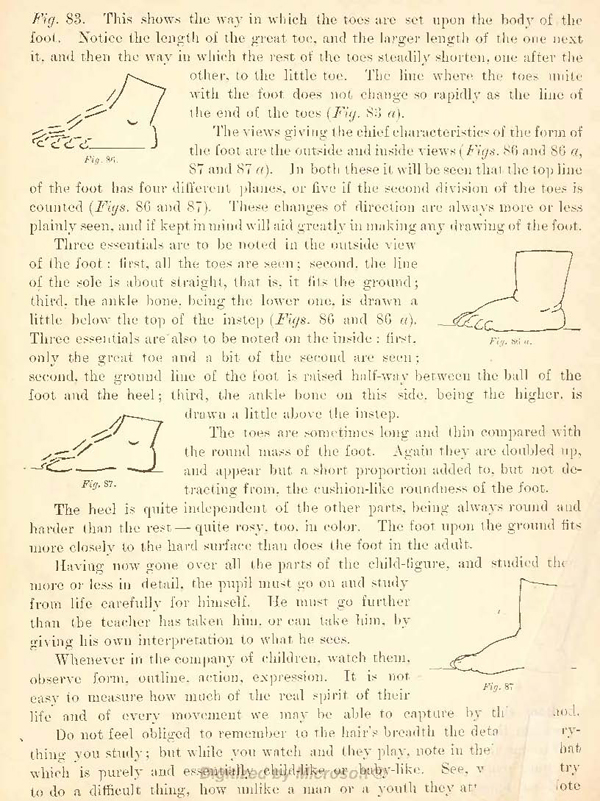
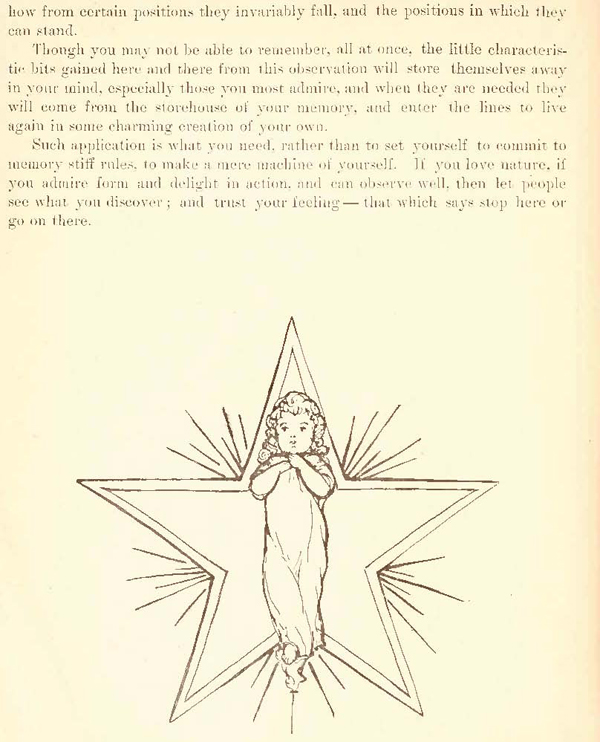
[The above words are pictures of text, below is the actual text if you need to copy a paragraph or two]
THE THIGH, LEG AND FOOT.
Drawing from the upper extremities to the lower, we find that, like the arm, the leg is in several sections : the thigh, corre sponding to the arm proper ; the leg, corresponding to the forearm ; the foot, corresponding to the wrist and hand.
As with the arm, it is well to study at the start the underlying framework. In the thigh there is one long bone called the femur, extending from hip to knee. In the leg there are two long bones, from knee to foot, called the tibia and the fibula (Fig. 82). The tibia is on the inside of the leg, and is much the larger of the two.
Just at the knee. where the thigh and leg bones articulate, there is a small bone called the patella or knee-pan. It helps in the action of theemuscles, and protects the joint (Fig. 82).
The point where the leg unites with the foot is called the ankle.
In the solid part of the foot there are seven small bones, which form the heel and that part of the foot on which the leg bones rest, and five long bones, which lead to the five toes. These twelve together form the heel and instep (Fig. 83).
In each of the toes, except the great toe. there are three free bones. Like the thumb, the great toe has but two free bones (Fig. 83).
The ankle bones semen projecting upon the outline (Fig. 83 a). are not formed by the small bones of the foot, but are the lower ends of the two long bones of the leg. The end of the tibia forms the inner ankle projection, the end of the fibula makes the outer projection. The inner or tibia projection is always higher than the outer, corning just above the instep, while the outer or fibula projection falls just below the instep.
After deciding upon them. allow yourself to add to these first three two other lines, and see if you cannot in them get the essentials of the whole form. A pupil cannot too often be reminded of this way of proceeding when starting upon a difficult task. In the three views of the lower extremity. front. side and back. in Fii. 84. observe that the outline on the outside is almost an un- 1 broken line —two long curves with sii.P•ht indentation at the knee. The inside outline, however, is much broken. that is, the direction is often changed.
The indentations about the knee should be studied. Observe that the points where the thigh and me leg begin on the outside are higher than where mey begin on the inside ; but at the lower end of the at the ankle, the opposite condition will be found, making the inside lentim of time entire limb shorter the outside length, in both back and front views. Time ankle bones seem to clasp the top of the foot.
Never allow the ankle and foot, to lie heavy. though they should be well covered with integument.
The views giving the chief characteristics of the form of the foot are the outside and inside views. In both these it will be seen that the top line of the foot has four different planes, or five if the second division of the toes is counted (Figs. 86 and 87). These changes of direction are always more or less plainly seen, and if kept in mind will aid greatly in making any drawing of the foot.
Three essentials are to be noted in the outside view of the foot : first, all the toes are seen; second, the line of the sole is about straight, that is, it fits the ground third, the ankle boner being the lower one, is drawn a little below the top of the instep (Figs. 86 and 86 a).
Three essentials are-also to be noted on the inside : first, only the great toe and a. bit of the second are seen; second, the ground line of the foot is raised half-way between the ball of the foot and the heel ; third, the ankle bone on this side, being the higher, is drawn a. little above the instep.
The toes are sometimes long and thin compared with the round mass of the foot.. Again they are doubled up, and appear but a short proportion added to, but not detracting from, the cushion-like roundness of the foot.
The heel is quite independent of the other parts, being always round and harder than the rest — quite rosy. too, in color. The foot upon the ground fits more closely to the hard surface than does the foot in the adult.
Having now gone over all the parts of the child-figure, and studied the more or less in detail, the pupil must go on and study from life carefully for himself. He must. go further than the teacher has taken him, or can take him, by giving his own interpretation to what he sees.
Whenever in the company of children, watch them. observe form, outline. action, expression. It is not ease to measure how much of the real spirit of their life and of every movement we may he able to capture. While you watch and they play, note in the flab which is purely and esintially child:like or baby-like. See, try, to do a difficult thing, how unlike a man or a youth they at how from certain positions they invariably fall, and the positions in which they can stand.
Though you may not be able to remember, all at once, the little characteristic bits gained here and there from this observation will store themselves away in your mind, especially those You most admire, and when they are needed they will come from the storehouse of your memory, and enter the lines to live again in sonic charming creation of your own.
Such application is what you need. rather than to set yourself to commit to memory stiff rules. to make a mere machine of Yourself. if you love nature. if you admire form and deli,y.ht in action, and can observe well, then let people see what you discover ; and trust your feeling that. which says stop here or go on there.




